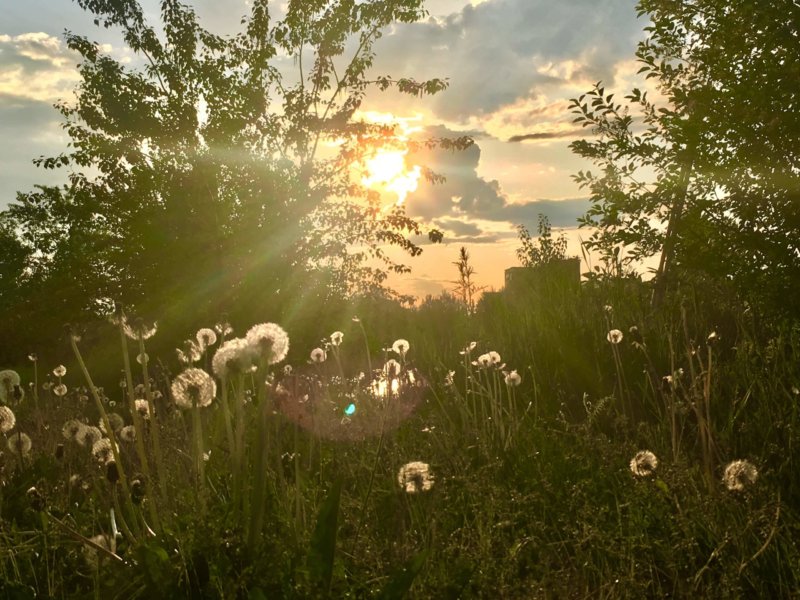Dandelions: Weed or Wonder?
by Cassie Sevigny
Broadcast 4.2021 and 4.24 & 4.27.2024

Photo by Cassie Sevigny.
Listen:
I looked out my window one spring morning to see the solid green yard below devoid of any flowers. The landscapers came by recently – maybe mowing chopped the flower heads off? But around 11am I glanced again to a lawn suddenly littered with yellow blooms, tiny scattered suns getting a late start to the day. The common dandelions, or Taraxacum officionale, persisted.
Perhaps the landscapers didn’t bother trying to remove the dandelions because they knew the effort would be futile. When I was a child, my dad taught me how to use a spade to dig deep to remove them from the root. Any bit of root left behind in the dirt could regrow. Winter also fails to kill off the perennial plant.
Why did we have to dig them up? I wondered. “They’re a weed,” my dad said. But they’re so pretty, I thought, collecting bundles to present to my mom at the end of long summer days. What makes them a weed? “People don’t like them,” my dad explained. “They spread fast, grow where we don’t want them to grow” – that is, all over our lawns – “and they’re hard to get rid of.” Hence the dirty spade in my hand. And yet I could not resist searching for the roundest, fullest seed heads, making a wish, and blowing the seeds into the wind. Every child knows if you get them all off in one go, your wish comes true. I preferred to consider each seed as its own wish with the potential to come true if it successfully planted. Much to my dad’s and neighbors’ dismay, if they knew.
And dandelions do so love our lawns, where they can take root in the disturbed soil and easily reach sunlight among the short grass. Humans’ age-old habits of building houses and infrastructure and digging up food have created ideal habitat for dandelions for thousands of years. But they haven’t always been hated and dubbed “weeds.” The plant originated in Europe and Asia, where people valued dandelions for medicine, food, and wine. The officionale part of the scientific name even comes from long-ago pharmacies keeping dandelions in stock. And the entire plant is edible! (But don’t try to eat any of the ones at your local park, as I did as a kid. They are very good at absorbing pesticides without dying!)
Dandelions migrated to much of the world by accident, as seeds blew on the wind or stuck to travelers. However, migrants from Europe brought them to America on purpose to continue the traditional uses of dandelions as food, drink, and medicinal herb. The flower may have pleasantly reminded immigrants of their former homes, too, in a new landscape. Not needing pollination to go to seed, dandelions spread across the continent faster than the European colonists. Settlers in the American West even relied on ground-up dandelion root as a coffee substitute in hard times!
Dandelions shifted from a plant so valued that people crossed oceans with a stash to the most-hated weed when lawns became a popular and “necessary” home feature. Suddenly the ubiquity we formerly cherished became the dandelion’s worst trait. This always struck me as fickle and arbitrary on our part. But dandelions do not care what we think of them. They just grow. Gazing out my window as the flowers opened for a spring morning, I saw the resilience and resourcefulness of a plant that grows unashamedly in yards and sidewalk cracks. I collected a small bundle of dandelions to place in a tiny vase in my kitchen. In doing so, I recognized the resilience and resourcefulness of humans, and my inner child delighted at the yellow puffs.
Every week since 1991, Field Notes has inquired about Montana’s natural history. Field Notes are written by naturalists, students, and listeners about the puzzle-tree bark, eagle talons, woolly aphids, and giant puffballs of Western, Central and Southwestern Montana and aired weekly on Montana Public Radio.
Click here to read and listen to more Field Notes. Field Notes is available as a podcast! Subscribe on iTunes, Google Play, or wherever you listen to podcasts.
Interested in writing a Field Note? Contact Allison De Jong, Field Notes editor, at adejong [at] montananaturalist [dot] org or 406.327.0405.
Want to learn more about our programs as well as fun natural history facts and seasonal phenology? Sign up for our e-newsletter! You can also become a member and get discounts on our programs as well as free reciprocal admission to 300+ science centers in North America!












